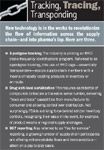Get a Grip on the Supply Chain
Pharmaceutical Executive
The Sarbanes-Oxley Act-or SOX, as it is dubbed (not always so affectionately)-requires companies to provide greater control and quality assurance across a vast spectrum of business processes. In practice, SOX plays out differently industry by industry and even company by company. But for pharma, one of the most pressing consequences is the need to improve the accuracy of revenue recognition.
The Sarbanes-Oxley Act—or SOX, as it is dubbed (not always so affectionately)—requires companies to provide greater control and quality assurance across a vast spectrum of business processes. In practice, SOX plays out differently industry by industry and even company by company. But for pharma, one of the most pressing consequences is the need to improve the accuracy of revenue recognition.

Chain Surgery
The devil, of course, is in the details. Given the industry's famously fragmented supply chain, achieving precision in revenue recognition has proved no small challenge for many pharmaceutical companies. Still, however costly and time-consuming in the short run, the effort is likely to have long-term benefits as e-pedigree tracking and other new initiatives revolutionize the flow of information upstream and down. Until these systems are up and running, a data-collection and-analysis approach developed by IMS Health can offer significantly greater insight into the supply chain, enabling pharmaceutical executives to hit higher levels of SOX compliance.
THE RIDDLE OF REVENUE RECOGNITION
A reaction to such spectacular financial meltdowns as Enron, Tyco, and WorldCom, the Sarbanes-Oxley Act demands that publicly traded corporations bolster their internal-control frameworks. The goal of the legislation is ultimately to increase the accuracy of the published financial statements upon which investors base their decisions.
In a way, SOX is less of a stretch for pharma than for other industries. Because quality is so important in drug development and manufacturing and because the industry is so regulated in the first place, drug makers and distributors already have a high compliance IQ. In essence, the companies have a culture of control.

Tracking, Tracing, Transponding
However, when it comes to issues of revenue recognition, the industry's much-segmented supply chain can make answering even the most basic questions seem like a run-in with the Sphinx. Try: When is a sale really a sale, and at what price?
Many factors are responsible for this fragmentation. For example, the industry's business model features large intermediaries or consolidators, such as McKesson and Cardinal, putting increasing distance between—and wielding increasing influence over—sellers and buyers. Widespread use of discounting and rebating to shape sales contributes to the uncertainty, as do product dating and other quality controls. Overall, it is a disparate distribution system ill-suited to precision in revenue recognition.
All of this is causing much grumbling among pharmaceutical executives. A basic Internet search on the subject of revenue recognition in the industry reveals not only a whirlwind of conferences but also a spike in the number of auditors and firms hunting for executives with relevant experience. Unquestionably, this is a key challenge for the pharmaceutical industry.
BEST GUESSES NOT GOOD ENOUGH
Against this backdrop, IMS was recently approached by a client facing a number of challenges in achieving full compliance with Sarbanes-Oxley rules. In particular, this drug maker wanted to restate several years of earnings statements. Its reported revenue recognition had been based on the commonly used "sell-in" model.
In a typical sell-in scenario, revenue is recognized when the product leaves the manufacturer's factory. (Essentially, the products are assumed to have been "sold in" to the marketplace.) But in practice, companies must adjust this figure, recognizing that it does not yet account for a whole host of probable—but often very unpredictable—contingencies.
For example, seller rebates are widely deployed throughout the industry. Though useful as a means of wooing large buyers, such as managed-care organizations, precise rebate levels complicate revenue recognition because they are almost impossible to anticipate. The same can be said for the industry's frequent charge-backs, contract-based discounts, returned goods, and list-price discounts.
Taken together, such post-factory events can greatly reduce the dollar value of sales—and therefore the revenue recognized for accounting purposes. As a result, companies use historical data relating to returns, discounts, and the like for a best guess of the total downward adjustment of recognized revenue. As long as this estimate is accounted for as a liability on the financial statement, the manufacturer is presumed SOX compliant. But if these best guesses are over-or underestimated by a significant degree, a company opens itself to second-guessing by regulatory authorities.
Any suspicions that regulators have set their sights on the revenue-recognition practices of pharma are well-founded. Though the SOX legislation doesn't target the industry emphatically, officials are keenly aware of past improprieties. In particular, some companies have inaccurately reported higher sales of and earnings from their products than the market could reasonably be expected to bear. Under the sell-in model, these shipments are counted as sales for revenue-recognition purposes.
The SOX regulations aim to eliminate or at least minimize such practices. Additional tests, including after-the-fact analyses, require greater accuracy and reliability. Companies that fail to meet these new standards face consequences ranging from lower stock valuations (as auditors assign lower ratings to the quality of the information reported) to the delisting of shares from public stock exchanges (a powerful incentive indeed).
In the end, IMS's client came to the conclusion that it not only needed to restate prior earnings but that the degree of variability in its entire forecast was unacceptable. Not content with a best guess, it opted for a closer approximation of what was actually taking place in its sales channels.
THE SUPPLY CHAIN IN REAL TIME
In industries from high-tech to retailing, financial services to manufacturing, the mantra in business intelligence is "real time." That's because the more a company knows about its actual stocking at the retail level, the better it can maximize inventories, production runs, advertising, and additional business processes. It can also better answer a slew of formerly riddling questions like: What is this retailer's inventory of my products right now? What sales patterns are developing that could affect demand right now? How much should we ship to this customer right now?
For large retailers like Wal-Mart in the United States or Tesco in Britain, knowledge of retail inventories and sales in real time (or near–real time) is readily achievable because it has to be—in order to avoid stockouts. The sophisticated mechanisms these chains have devised for sharing data with manufacturers and distributors keep products on shelves, prices low, and customers happy. That's the incentive for retailers—who basically own the supply chain and whose business models are based on competitive costs—to collaborate with manufacturers. Accordingly, manufacturers "in the loop" have real-time information to exploit across a range of critical business processes.
By contrast, the systems available to pharmaceutical companies for capturing retail and inventory data look, well, Stone Age. And for good reasons. Most of all, until SOX, there was little incentive for tracking actual sales of drugs and other pharma products because demand has tended to have little to do with price. For that matter, price has tended, at least until recently, not to be an issue. (The growing competition from generics is, of course, increasing the influence of cost.) In addition, product volumes tend to be lower. As a result, managing retail costs more actively never much mattered to the participants of the supply chain.
Combined with a lack of incentive on pharma's part are a daunting number of disincentives, starting with the chasm between manufacturers and the point of sale. Because companies are prohibited from direct interaction with their end-users—the patients—products are sold through intermediate distributors, then transferred to customer groups ranging from pharmacies to physicians, hospitals, and clinics. This, in turn, makes for an enormously diverse range of contract structures.
Such a highly regulated and segmented setup allows companies little visibility into the downstream demand chain. The many rebates, discounts, charge-backs, product dating, and gross-to-net deductions only further complicate the accuracy of revenue recognition.
SOX COMPLIANCE AND BEYOND
The good news is that change is on the way. As a whole, the industry recognizes the value of improving the flow of information across the supply chain. In the offing are a handful of innovative (and sometimes competing) inventory-and sales-focused data-tracking initiatives. Though it is difficult to forecast winners or losers—or when any will be fully up and running—the best options include the following: e-pedigree tracking, drug unit-level serialization, and 867 reporting (see "Tracking, Tracing, Transponding").
While these initiatives are currently in pilot form, none is expected to be widely deployed any time soon. Meantime, with SOX compliance cops breathing down pharma's neck, companies are scrambling for accurate and timely methods of inventory tracking.
Early discussions between IMS and its drug-manufacturer client made it apparent that IMS's access to industry data could be leveraged as a tool for constructing a clearer picture of sales-related activity and, ultimately, better revenue recognition. Essentially, IMS's relationships with wholesalers, retail pharmacies, hospitals, clinicians, and other participants enable the company to capture transaction dynamics across many points in the shipment/supply chain. In practice, it accesses about 94 percent of pharmaceutical product sales through all channels in the United States.
Following a number of adjustments, the information from the IMS database can be combined with relevant supplementary sources (retail takeaway information and projected data to account for the 6 percent not covered), put through a series of calculations, and validated (see "Chain Surgery").
Increased visibility into the supply chain can be used for far more than SOX compliance. For example, IMS's client is currently studying how greater knowledge of inventory in near–real time might be used not only to refine its rebate strategies—say, by determining the overall effectiveness—but also to make real-time decisions, such as when to offer which level of rebate to which channel.
For the industry as a whole, greater insight into ongoing cyclical, regional, and other sales and distribution trends enables better management of product flow. This leads to fewer lost sales (through the avoidance of stockouts), greater anticipation of distribution bottlenecks, and generally lower costs through optimized inventory levels. Other potential advantages include optimized manufacturing runs, improved marketing insight, more dynamic pricing and rebates, better sales-force management, and clearer linkages to performance.
As real time moves from business mantra to business reality, supply-chain information can help firms respond both dynamically and strategically. Companies investing in state-of-the-art inventory assessment for SOX compliance will likely find that they also have reaped a crop of critical intelligence on product demand and performance. Ultimately, this allows firms to adjust quickly and competitively to an ever-changing marketplace.
Lisa Papworth is a principal for product and portfolio development for IMS Management Consulting and can be reached at lpapworth@us.imshealth.comTim Kelly is IMS practice leader for promotion management and can be reached at tkelly@us.imshealth.comStuart Kamin, an IMS consultant, also contributed to this article. He can be reached at skamin@us.imshealth.com

The Misinformation Maze: Navigating Public Health in the Digital Age
March 11th 2025Jennifer Butler, chief commercial officer of Pleio, discusses misinformation's threat to public health, where patients are turning for trustworthy health information, the industry's pivot to peer-to-patient strategies to educate patients, and more.
Pfizer, GSK Gain ACIP Recommendations for RSV and Meningococcal Vaccines
April 18th 2025The Centers for Disease Control and Prevention’s Advisory Committee on Immunization Practices voted to expand access to Pfizer’s respiratory syncytial virus vaccine Abrysvo for high-risk adults in their 50s and voted in favor of GSK’s meningococcal vaccine, Penmenvy, for streamlined adolescent protection.